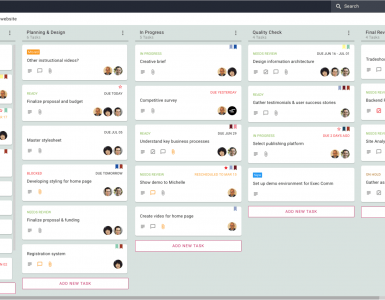
As a freelancer, it’s common to experience the feast or famine cycle – periods of too much work followed by stretches of little to no projects. This inconsistent workflow can cause stress and financial instability. In this blog post, we’ll explore strategies to help you maintain a steady flow of work and overcome the feast or famine cycle.
Diversify Your Client Base
- Tap into multiple industries: Expand your reach by targeting clients from various industries. This will help reduce dependency on a single sector and provide you with a more diverse range of projects.
- Utilize social media and online platforms: Leverage the power of social media to showcase your work, engage with potential clients, and join relevant groups or communities. Utilize freelance platforms like Twine to find new clients and projects.
- Collaborate with other freelancers: Partnering with other freelancers in complementary fields can lead to referrals and new clients. This approach can help you access projects that require a broader range of skills and expertise.
- Offer a wider range of services: Diversify your skillset by learning new tools, techniques, or technologies. Offering a wider range of services can make you more attractive to potential clients and increase your chances of landing new projects.
Create Recurring Revenue Streams
Creating recurring revenue streams is essential for freelancers looking to maintain a steady income and reduce the impact of the feast or famine cycle. Here are some strategies to help you create recurring revenue streams:
- Retainer agreements: Offer your clients retainer agreements, where they pay a fixed monthly fee for a set amount of work or hours. This arrangement provides clients with ongoing access to your services and ensures a predictable income for you.
- Maintenance packages: For freelancers working in fields like web development, graphic design, or marketing, consider offering maintenance packages. These packages can include regular updates, bug fixes, or content management, providing clients with ongoing support and generating consistent revenue for you.
- Subscription-based services: Develop subscription-based services or products that require clients to pay a recurring fee for continuous access. Examples include online courses, memberships to exclusive content, or ongoing coaching/consulting services.
- Upsell and cross-sell services: Identify opportunities to upsell or cross-sell additional services to your existing clients. For example, if you’re a web designer, you can offer ongoing search engine optimization (SEO) services or social media management to help your clients maintain their online presence.
- Partner with complementary businesses: Collaborate with businesses that offer complementary services to create bundled packages or referral partnerships. This approach can help both parties generate recurring revenue while providing clients with comprehensive solutions.
By focusing on these strategies, you can create a more consistent income stream, better manage your workload, and ultimately achieve greater financial stability as a freelancer.
Network and Build Relationships

- Network at events and conferences: Attend industry-specific events, conferences, and meetups to connect with potential clients. Networking can open doors to new opportunities and help you build long-lasting professional relationships.
- Join online communities and engage with potential clients on social media
- Maintain relationships with existing clients for repeat business
Improve Your Online Presence
Improving your online presence is essential for attracting new clients and diversifying your client base. Here are some key steps to help you enhance your online presence as a freelancer:
- Optimize your website: Ensure your website is professional, easy to navigate, and effectively showcases your skills and expertise. Make sure it’s mobile-friendly, loads quickly, and is optimized for search engines (SEO) so potential clients can easily find you online.
- Create a compelling portfolio: Develop a strong portfolio that highlights your best work and demonstrates your capabilities. Include case studies, testimonials, and detailed descriptions of the projects you’ve completed to showcase the value you can provide to potential clients.
- Be active on social media: Choose relevant social media platforms to engage with your target audience and share valuable content. Regularly post updates, share your work, and interact with your followers to build relationships and establish yourself as an authority in your field.
- Write a blog: Start a blog on your website to share your knowledge, insights, and experiences in your industry. Consistently posting high-quality, engaging content can help you attract new clients, demonstrate your expertise, and improve your search engine rankings.
- Join online communities and forums: Participate in online communities, forums, and discussion groups related to your niche. Engage in conversations, provide helpful advice, and share your expertise to build your reputation and network with potential clients.
- Leverage LinkedIn: Optimize your LinkedIn profile, showcase your skills and accomplishments, and connect with professionals in your industry. Actively engage in relevant groups, share valuable content, and reach out to potential clients through LinkedIn’s networking features.
By investing time and effort into improving your online presence, you’ll increase your visibility, credibility, and reach, ultimately helping you attract a more diverse range of clients and grow your freelance business.
Utilize Freelance Platforms
- Join platforms like Twine to connect with potential clients.
- Regularly update your profile and apply for relevant projects.
Develop a Marketing Plan
- Identify your target audience: Start by defining your ideal client profile. Consider factors like industry, company size, location, and budget. Understanding your target audience will help you create more focused and effective marketing efforts.
- Create a strategy to reach them: Develop a multi-channel marketing strategy to engage your target audience. This may include content marketing, social media, email campaigns, and paid advertising. Regularly evaluate and adjust your strategy based on performance data and feedback.
- Allocate time and resources: Set aside dedicated time and resources for your marketing activities. Create a marketing calendar to plan your campaigns, track your progress, and ensure you’re consistently promoting your services.
- Measure your success: Regularly track and analyze your marketing efforts’ performance using key performance indicators (KPIs), such as website traffic, leads generated, and conversion rates. This will help you identify areas for improvement and optimize your marketing strategy.
Refine Your Proposal Process
- Create a compelling pitch: Develop a persuasive pitch that showcases your unique value proposition and highlights your skills, experience, and past successes. Use compelling storytelling to engage potential clients and demonstrate your ability to solve their problems.
- Personalize proposals: Tailor each proposal to address the specific needs, goals, and pain points of your prospective client. Show them that you’ve taken the time to understand their business and can offer customized solutions to help them achieve their objectives.
- Include testimonials and case studies: Build trust and credibility by incorporating client testimonials and case studies into your proposals. Share examples of your past work and demonstrate how you’ve helped other clients achieve their goals.
- Follow up: After submitting your proposal, make sure to follow up with the prospective client in a timely manner. This shows your commitment and interest in their project, and it can be the difference between winning and losing a contract.
Collaborate with Other Freelancers

- Partner with freelancers who offer complementary services to expand your offerings
- Share leads and referrals to increase project opportunities
Manage Your Time Effectively
Managing your time effectively is crucial for freelancers who want to overcome the feast or famine cycle and maintain a steady flow of work. Here are some strategies to help you manage your time more efficiently:
- Prioritize tasks: Start by making a list of all the tasks you need to complete and categorize them based on their importance and urgency. Focus on the most critical tasks first, and tackle less important ones later.
- Set clear goals: Define specific, measurable, achievable, relevant, and time-bound (SMART) goals for your freelance business. Break down larger goals into smaller, manageable tasks and allocate time for each task to keep yourself on track.
- Use time management tools: Utilize tools like to-do lists, calendars, and time tracking apps to help you stay organized and manage your workload efficiently. Tools like Trello, Asana, or Todoist can help you keep track of your tasks and deadlines, while time-tracking apps like Toggl or Harvest can help you monitor your productivity.
- Establish a routine: Create a consistent daily routine that includes dedicated time for work, breaks, and personal activities. Having a structured routine can help you stay focused and maintain a healthy work-life balance.
- Minimize distractions: Identify the distractions that hinder your productivity and take steps to eliminate or reduce them. This may include turning off notifications, using noise-canceling headphones, or creating a dedicated workspace free from distractions.
- Learn to delegate: If you find yourself overwhelmed with tasks, consider delegating or outsourcing some of your work to other freelancers or virtual assistants. This will free up your time to focus on higher-priority tasks and help you maintain a steady flow of work.
- Set boundaries: Clearly communicate your working hours to clients and avoid overcommitting to projects. Establishing boundaries will prevent burnout and help you maintain a healthy work-life balance.
By implementing these time management strategies, you can work more efficiently, stay on top of your workload, and ensure a steady stream of projects, ultimately helping you break free from the feast or famine cycle.
Continuously Upskill and Adapt
- Continued education and professional development are crucial for freelancers to remain competitive in the ever-changing landscape of their industries. By investing in learning new skills, freelancers can expand their expertise and offer their clients a wider range of services. They can also stay up to date with emerging trends and technologies that may affect their work. Freelancers can enroll in online courses, attend conferences and workshops, or join professional organizations to expand their knowledge base and network with other professionals in their field. Some platforms even offer free or low-cost courses and resources, making it easier for freelancers to invest in their professional development without breaking the bank.
- The market is constantly changing, and freelancers must adapt to keep up. This means staying informed about industry trends, changing client needs, and emerging technologies. Freelancers who can identify and respond quickly to these changes are more likely to succeed in the long term. Additionally, freelancers should always be updating their skills to stay relevant in their industry. This may mean learning new software, taking on new types of projects, or even expanding into new areas of expertise. By adapting to market changes and updating their skillset accordingly, freelancers can continue to provide value to their clients and remain competitive in their field.
Overcoming the feast or famine cycle is possible by proactively managing your freelance business. By diversifying your client base, creating recurring revenue streams, networking, improving your online presence, utilizing freelance platforms, developing a marketing plan, refining your proposal process, collaborating with other freelancers, managing your time effectively, and continuously upskilling, you can maintain a steady flow of work and enjoy a more stable and successful freelancing career. Twine offers resources, tools, and a community to help you thrive in your freelancing journey.








